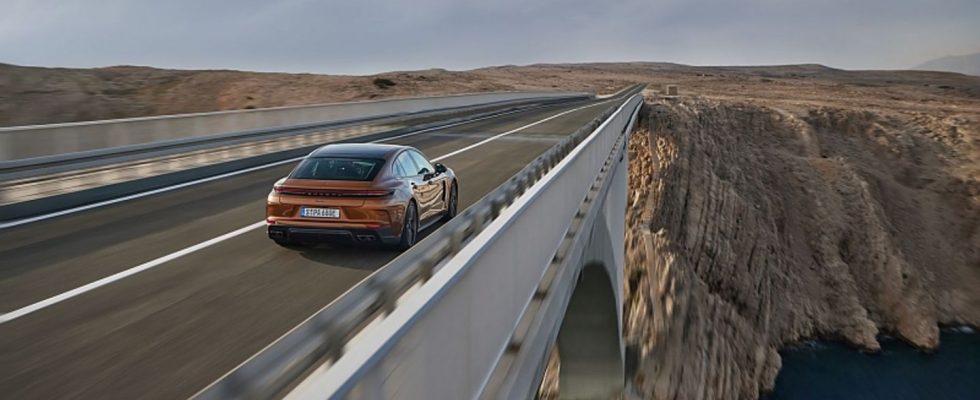New introduction: Porsche Panamera III
Third serve
Porsche Panamera III
© press-inform – the press office
With the third generation of the Panamera, Porsche is digging deeper into the technology shelf than ever. The highlight is the active chassis, which even notices bumps. The infotainment will be updated and the plug-in hybrid versions will have more range.
Porsche means sportiness. This is how the Zuffenhausen-based car manufacturer sees itself. Modern technology helps to resolve the constant conflict between comfort and agility. Agility is crucial. In order to achieve this without compromising comfort too much, the engineers install an active chassis by combining a single-chamber air spring with hydraulic dampers that always keep the body horizontal and smoothly compensate for unevenness. In order to ensure control that is both quick (every millisecond) and sensitive, there is a separate hydraulic pump on each wheel and a control unit on each axle. This delicate play with the rebound and compression stage makes 48-volt roll stabilization unnecessary.
The fact that you can save obstacles at the push of a button and that the chassis is already prepared via GPS for the next time you drive over them increases comfort, as does the fact that the air springs raise the body by 55 millimeters when getting in and out. The rear axle steering and the typical Porsche driving programs ensure sportiness. In order to get the most out of the Gran Turismo, the developers are exhausting all technical possibilities. Sensors monitor the tire lateral forces and, if necessary, the chassis quickly increases the load on a tire. “We are exploiting the potential of the tires. A few percent here and there and the whole thing becomes more dynamic,” explains chassis manager Dr. Ingo Albers.
However, the Porsche Active Ride suspension can initially only be ordered as an option for the hybrid models. A two-chamber, two-valve air suspension with Porsche Active Suspension Management (PASM) is installed as standard. For the market launch in March 2024, Porsche is rolling out the Panamera Turbo E-Hybrid, whose drive train consists of the improved four-liter V8 turbo engine and a newly developed electric motor (now an internal rotor with an internal movable rotor) with 140 kW / 190 hp a system output of 500 kW / 680 HP and a torque of 930 Newton meters. To match this, the technicians have revised the eight-speed dual-clutch transmission in which the electric motor is located. The longitudinal dynamics are corresponding: from a standstill, the Panamera Turbo E-Hybrid accelerates to 100 km/h in 3.2 seconds and reaches a top speed of 315 km/h.
Like the Cayenne, the battery now has a capacity of 25.9 kilowatt hours (previously 17.9 kWh), which should guarantee a maximum range of 91 kilometers, but also packs 30 kilograms more into the car. The fact that a car that costs at least 107,800 euros (Panamera Turbo E-Hybrid: 192,500 euros) only has an 11 kW onboard AC charger is no longer appropriate. If everything goes smoothly, the batteries will be filled again in two hours and 39 minutes.
It won’t stop with the powerful part-time electric car. A six-cylinder PHEV will follow later. There will be a total of four hybrid variants of the new Panamera, including a Turbo S steam hammer and probably two variants with all-wheel drive and rear drive, which are coupled with the V6 engine. At the beginning, the 2.9-liter six-cylinder gasoline engines still have to make do without electrical support. The turbo engine produces 260 kW / 353 hp and has a maximum torque of 500 Nm – an increase of 17 kW / 23 hp) and 50 Nm compared to its predecessor. The performance of these models is also sufficient. The Panamera completes the standard sprint from zero to 100 km/h in 5.2 seconds and can reach a maximum of 272 km/h. For the all-wheel drive Panamera 4 it is 4.8 seconds and 270 km/h.
As before, the Panamera will be available in two length variants: the standard version is 5.052 meters, the executive model with a long wheelbase is 5.202 meters. The interior with the curved monitors is based on the Cayenne and also offers the 10.9-inch passenger screen on request. Like its SUV brother, the automatic knob has been moved up and the infotainment has been improved. It is now standard that the smartphone can be linked via Apple CarPlay or Android Auto. The infotainment doesn’t offer an orgy of graphics, but you can quickly find your way around.

